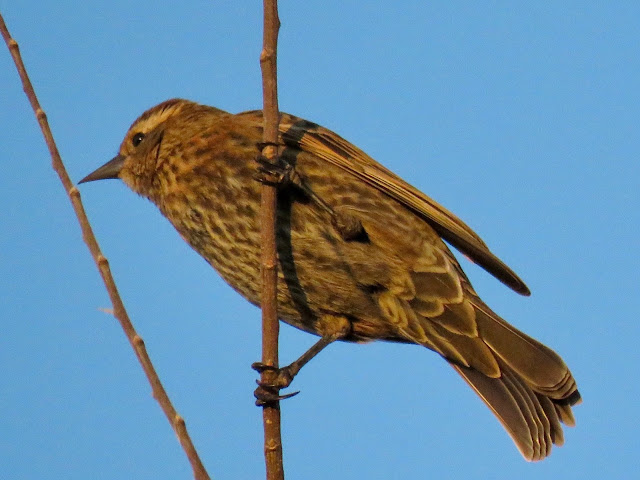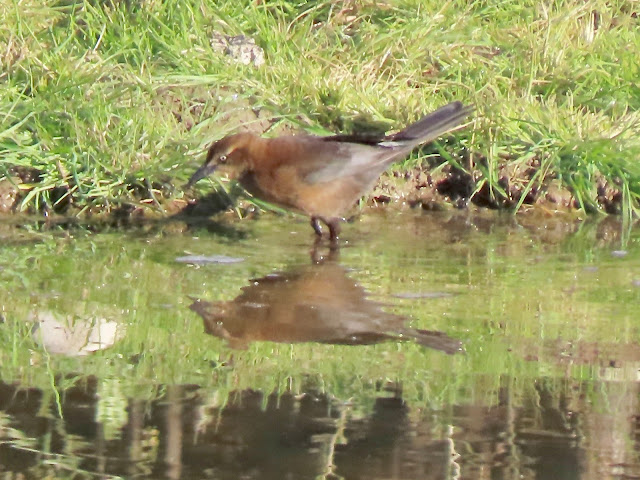It was another cold morning in the Arizona desert: 39°F when I pulled out of my driveway after 7 a.m. -- a late start for me, but it was brrrr time and it felt good to stay under the covers a bit longer.
As I watched the external temperature register in the car, it didn't go up; it went down one degree at a time until I reached Coon Bluff in 29°F. No other cars were present. The air was still. I had the place to myself.
Surprising to me, and maybe an educational moment, the cold didn't appear to affect bird life. The sun was up and birds were everywhere. I could hear many and see some. Eventually, I think I saw the greater percentage of them. Dressed warmly, the cold bothered only my fingers.
Counting over a dozen PHAINOPEPLA perched up on mesquite trees as I drove into the parking lot, there were even more when I started birding. I settled on a total count of 21 that may be quite conservative. Males and females were vocalizing and chasing one another all over the place.
 |
| PHAINOPEPLA (male) |
 |
| RED-WINGED BLACKBIRD (female) |
 |
| RED-NAPED SAPSUCKER (male, above & below) |
 |
| GILA WOODPECKER (male) fluffed and catching some sun |
 |
| VERMILION FLYCATCHER (male, above and below) |
LESSER GOLDFINCH were feasting on the flowers in the thick, lush ground cover that has sprung up since fencing was installed (maybe a month ago?) I hadn't visited Coon Bluff in well over a month and had not yet seen the fence installed along the river. As much as I like the wild (feral) horses, the bands have expanded in population to the point that it has been several years since there was any green plant life in the sandy desert mesquite floor. If it's because of the fence, so be it. All creatures need to eat and the number of birds I saw today tells me they love the thick spreading green ground cover.
 |
| LESSER GOLDFINCH (male), in particular were feasting within the ground cover but took flight and perched up when I walked through. |
 |
| NORTHERN CARDINAL male |
 |
| AMERICAN PIPIT (above and two below) |
Happenstance challenges like this put the extra kick into birding!
Not a big challenge, this GREAT BLUE HERON below is a juvenile based on plumage and bi-colored bill. It's always in the details.
The GREATER YELLOWLEGS below is a challenge in that it needs to be discerned from the slightly smaller LESSER YELLOWLEGS. The Lesser has a shorter straighter bill than this bird. The Greater's bill has a slight up curve not easily seen in this photo but it vocalized its "tew...tew...tew".
 |
| GREATER YELLOWLEGS |
 |
| BLACK PHOEBE |
 |
| Distant BELTED KINGFISHER (male) |
In the field, I couldn't tell for certain. So, again, photos are my go-to instructor when I get home to compare/contrast photos with my field guides. Conclusion (of which I'm still not certain but have not yet heard from the reviewer of eBird) was that it was a female BOAT-TAILED GRACKLE. (unusual here) Our GTGR are not so brown all over and the wings on the bird below appears to be smaller than our GTGR and appears to me to have a shorter tail than the GTGR.
 |
| BOAT-TAILED GRACKLE (3 photo series) |
Dear Babs Buck,
Thank you for being a part of eBird. To help make sure that eBird can be used for scientific research and conservation, volunteers like me follow up on unusual sightings as a part of the eBird data quality process.
I noticed your Boat-tailed Grackle report on the checklist below and also looked at your photo and have come to the conclusion that it is a female Great-tailed Grackle. I studied the differences in plumage between female grackles last year in preparation for a birding trip to the coast of TX (where all three grackle species occur) using a large number of images from the Macaulay Library. If you are interested, I can send you two composite images I made (not with my own photos) that I used to study and organize points for female grackle ID. In the end, my reasoning for IDing your bird as a Great-tailed Grackle is mainly that Boat-taileds almost never wander outside of their expected range (if they do show up anywhere unusual it is almost always a location adjacent to an area where are known to occur) and that female Boat-taileds from the Texas, Gulf Coast, and Florida populations have duskier irises unlike a female Great-tailed's pale whitish iris. I hope you find this helpful and please feel free to email me with any questions/concerns you may have.
Species: Boat-tailed Grackle
Count: 1
Observation Date: Feb 7, 2020
Location: Salt River--Coon Bluff Recreation Area, Maricopa, Arizona, US
https://ebird.org/checklist/S64206268
Thank you again for your contributions to eBird—your sightings help to make eBird useful to millions of people each year, providing real-time bird sightings and powering eBird science around the world.
Good birding,
Joshua Smith
Joshua1vs89@icloud.com
Josh kindly sent photos of various blackbirds from Cornell's Macaulay Library. I've copied the pertinent female Great-tailed Grackle and female Boat-tailed Grackle photos below.
For comparison, below is a photo of what I saw.
Hi Babs,
Yes, I am confident that your bird is a female Great-tailed Grackle. It is one of the more warm light brown-colored individuals but is definitely within variation for GTGR.
Good birding,
- Joshua
When I asked him to confirm that he intended my photo was of the top species, not the bottom, he responded (as above) with confirmation of his ID that my photo was of the top species, GREAT-TAILED GRACKLE! So, at the very least, I have a photo of a female GREAT-TAILED GRACKLE, the likes of which I've never seen before.
I neglected to take pictures of the new thick ground cover but it was sparrows hiding in these grasses/plants over the years that got me interested in learning how to identify sparrows. Not having the ground cover meant very few sparrows in the mesquite bosque recently. I'm hopeful that they will discover, as the LESSER GOLDFINCH already have, that the protective habitat and food source have returned.
Click the link below to see the list submitted to eBird.
* * *
View this checklist online at https://ebird.org/checklist/S64206268










No comments:
Post a Comment